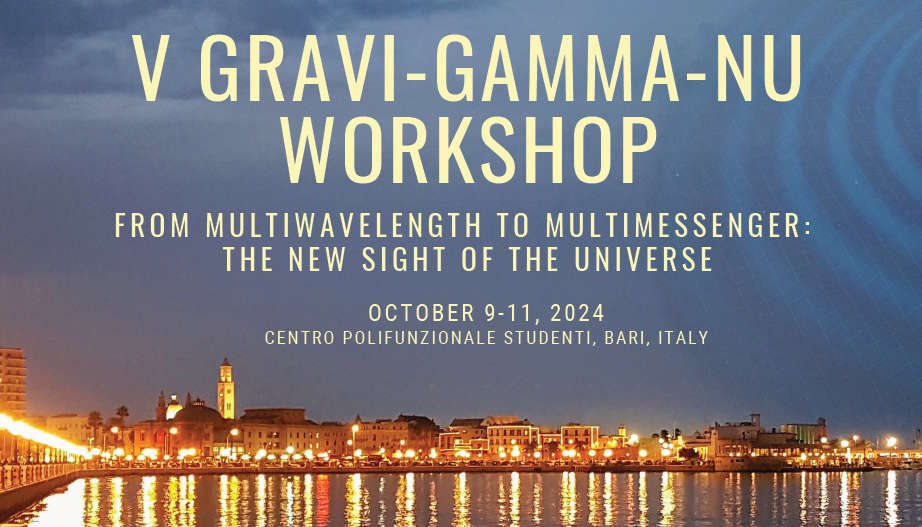Conveners
Day 1: Latest results
- Massimiliano Razzano (University of Pisa and INFN-Pisa)
Day 1: Latest results
- Massimiliano Razzano (University of Pisa and INFN-Pisa)
Day 1: Latest results
- Elisabetta Bissaldi (Istituto Nazionale di Fisica Nucleare)
Day 1: Latest results
- Melissa Pesce-Rollins (Istituto Nazionale di Fisica Nucleare)
The main goal of the Pulsar Timing Array is to regularly monitor tens of millisecond pulsars in the radio band to detect dynamic perturbations of the space-time metric, such as those caused by the passage of gravitational waves. So far, pulsar networks are the only way to detect gravitational wave emission in the nanohertz frequency range. The talk will discuss the current status of Pulsar...
Pulsar Timing Array experiments can probe the presence of possible scalar
or pseudoscalar ultralight dark matter particles through decade-long timing of
an ensemble of galactic millisecond radio pulsars. If dark matter interacts only
gravitationally with ordinary baryonic matter, our findings show that ultralight
particles with masses 10$^{−24.0}$ eV $\leq$ m $\leq$ 10$^{−23.3}$ eV can...
The brightest of all time (BOAT) GRB 221009A has been observed across all the electromagnetic spectrum. The observations of the BOAT in the MeV gamma-rays have revealed a presence of a new feature in the spectrum of the prompt emission - a narrow and variable MeV line. The early GeV and TeV observations have allowed for the detailed characterisation of the afterglow radiation of the BOAT. In...
By releasing the first image of the black hole shadows of M87 and Sgr A, the EHT Collaboration has achieved one of the most illustrious scientific results of the last few years. Beyond the formidable technical accomplishment, the two images had a fundamental impact on our understanding of the physics of black holes and AGNs, and provided a further striking confirmation of general relativity....
The observation by the LHAASO Collaboration of the gamma-ray burst GRB 221009A at energies up to (13-18) TeV challenges conventional physics. This GRB originated at redshift z = 0.151, whence emitted photons at energies above 10 TeV are hardly observable on Earth due to their interaction with the extragalactic background light (EBL) photons. Indeed, if the most recent and accurate EBL model to...
Cosmic rays prove that our Universe hosts elusive astrophysical ”monsters” capable of continuously and efficiently accelerate particles at extreme energies. High-energy photons and neutrinos may provide the ultimate key to decipher the mystery of cosmic rays. Amongst the most promising neutrino candidate sources of high-energy neutrinos there are blazars, active galactic nuclei hosting a...
Pulsar Timing Array (PTA) experiments use well-timed pulsars to probe the gravitational universe at frequencies down to a few nanohertz. This band is populated by gravitational waves emitted by binary systems of supermassive black holes (SMBHBs). The most common signal sought by PTA experiments is a stochastic gravitational wave background generated by the superposition of hundreds of...
Although the recent evidence presented by Pulsar Timing Arrays (PTAs) is that for a stochastic Gravitational Wave Background (GWB), which was most likely produced by the superimposition of several GW signals, simulations of the merger history of supermassive black hole binaries (SMBHBs) suggest a narrow possibility of the detection of some of the most massive or fortunately located individual...
Black hole-neutron star (NSBH) coalescence events are regarded as highly significant phenomena within the current multimessenger framework of gravitational waves,
and they are poised to assume an increasingly prominent role in the foreseeable future. To date, only a handful of such events have been observed,
with GW200105 and GW200115 being the most noteworthy among them. However, with the...
KM3NeT is a deep-sea telescope aimed at detecting neutrinos. It is composed of two instruments: ARCA and ORCA. ARCA is mainly aimed at searching for astrophysical sources of TeV-PeV neutrinos, while ORCA is mainly dedicated to the study of neutrino oscillations. Despite their different goals, both instruments can participate in a multi-messenger search by providing information about neutrinos...
Gamma-ray observations of astrophysical neutrino sources are fundamentally important for understanding the underlying neutrino production mechanisms. We investigate the Cherenkov Telescope Array Observatory (CTAO) prospects for detecting the very-high-energy (VHE) gamma-ray counterparts to neutrino-emitting extragalactic sources. The performance of CTAO under different configurations...
Core Collapse supernovae are among the most interesting source of possible multimessenger detections, given the joint production of electromagnetic, neutrino and gravitational waves (GW). In this work we investigate the correlation of SASI structure of neutrino and GW to enhance the GW detection. We compare different search analyses for the case of a benchmark three-dimensional CCSN simulation...
We investigates the accretion of neutron stars (NSs) in active galactic nucleus (AGN) accretion discs. We classify potential accretion modes of NSs in AGN discs, proposing a hierarchical model of NS accretion: accretion flow from the Bondi sphere to accretion columns. The accretion of NSs in AGN discs differs from that of BHs, especially within the scale of the NS’s magnetosphere due to its...
Prompt emission of GRB is believed to be produced from electrons accelerated up to non thermal energies in the internal shocks. This emission peaks in the keV-MeV energy band, but a high energy (HE, 0.1 < E <100 GeV) component is theoretically expected. While photons in the very high energy (VHE; E > 20GeV) domain have been detected by Imaging Atmospheric Cherenkov Telescopes in recent years,...
The detection of a double-peaked broadband spectral energy distribution in the long GRB 190114C highlights the need for a systematic study of Gamma-Ray Burst (GRB) temporal and spectral evolution. This study will examine multi-wavelength observations of GRB afterglows, analysing their spectral evolution across seven orders of magnitude in energy, ranging from 0.3 keV to 107 keV. The sample...

